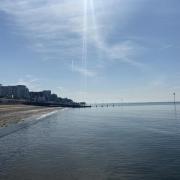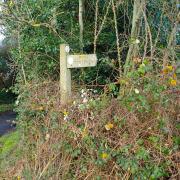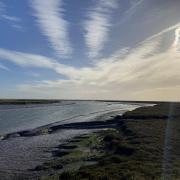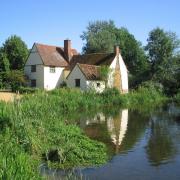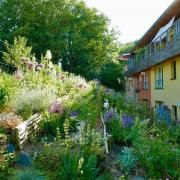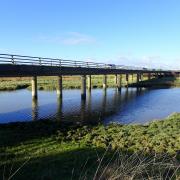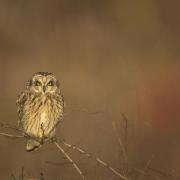From William Shakespeare through to H G Wells, Essex has a rich literary heritage and this is something that James Canton has had a passion for for much of his adult life.
‘In following these literary trails there was a sense of trying to engage not only with writers and their works, but with their experiences of the landscapes of Essex,’ says James. His new book, Out of Essex, sees him uncover the writers who have been inspired or influenced by our county and his quest has seen him weave his way along the lanes and byways of Essex to discover the county’s links to many famous writers.
That journey has taken him from Victorian murder and ghostly intrigues on Mersea Island to the site of Daniel Defoe’s Tilbury tile factory, via Colchester, Chelmsford and Southend and with detours to Epping Forest, the Dengie Peninsular and other far flung locations.
This tour has been an attempt to offer a cultural riposte to the idea of the county which seems to have grabbed hold of the popular imagination thanks to the easy stereotypes of Essex man and Essex girl, alongside recent representations on TV’s The Only Way is Essex (commonly known as TOWIE). People think they know Essex, but James, who is a tutor on the University of Essex’s Wild Writing course, is keen to surprise.
‘Essex is a land with a rich literary past. But in recent years this has been forgotten,’ James argues. ‘Stereotypes are not kind, nor are they easy to shift.’
For James, the county’s literary heritage dates back at least to the 10th century and the epic poem detailing the Battle of Maldon which is now seen as one of the most important surviving examples of Anglo-Saxon literature. Since then, writers have continued to come to Essex for all kinds of reasons and have drawn inspiration from the area.
Arthur Ransome chose to base Secret Water, one of his Swallows and Amazons books, at Hamford Water close to Walton on the Naze, H G Wells wrote Mr Britling Sees It Through about the traumatic impact of World War I at Little Easton and Daniel Defoe’s Moll Flanders is very much a Colchester girl.
James explains: ‘It is just over ten miles from TOWIE’s heartland of Brentwood to Stanford le Hope, where Joseph Conrad first settled in England and where he forged his distinctive form of writing style and began to structure Heart of Darkness. Stroll a few miles further down the road to Tilbury and you can stand on the spot where Daniel Defoe had a home.’
Conrad, the Polish author who became one of the greatest novelists in English, and Defoe, the creator of Robinson Crusoe, are just two of the writers James searches out and tries to find contemporary evidence for and he likes to mix literary detective work with personal responses to the landscapes and sites where writers lived or which they featured in their work.
Shakespeare is another writer James pursues, after finding out about the local legend that he wrote A Midsummer Night’s Dream while staying at a guest house in Castle Hedingham. He was particularly thrilled when he discovered a secluded hill nearby his home which was once known as Puck’s Hill.
James is also keen to highlight writers who might have been overlooked or those whose connections to Essex are at risk of being forgotten. Many will not know that Chelmsford offers the starting point for perhaps the most celebrated and influential example of British nature writing from the 20th century – JA Baker’s The Peregrine. The bulk of Baker’s book is a series of diary entries that track one year in the life of a pair of Essex peregrines and his obsession with the birds means he is able to become ever more intimate with every aspect of their lives. James has done all he can to discover more about the reclusive figure of Baker and has retraced his steps along the River Chelmer.
‘He came to know the patterns of the birds’ lives, their bathing places in the streams which fed the Chelmer, their favoured perches. As he tracked them, so the birds came to know him,’ says James.
Baker’s work symbolises the way Essex can inspire in surprising ways. He offers a new way of seeing the lands of the Chelmer Valley and the Blackwater Estuary. It also reminds us that the landscape and wildlife we sometimes take for granted are endlessly fascinating.
‘There is something wonderfully romantic,’ adds James, ‘in the notion of Baker as a social recluse, itinerant worker and wanderer of Essex who found something on which to fix his mind and who, with no training, lifted his pen, tracing and retracing his words until he achieved a masterpiece.’
Five of our county’s
literary highlights
Walton on the Naze
Hamford Water is close to this famous seaside resort and was the setting for Arthur Ransome’s Secret Water – the eighth book in his Swallows and Amazons series.
Chelmsford and the Chelmer River valley
JA Baker’s The Peregrine is partly a tribute to a vanishing rural world, but you can still walk the landscape through which the writer wandered.
Stanford le Hope
Joseph Conrad lived in Essex and described the area in several novels including Heart of Darkness.
Mersea Island
Sabine Baring-Gould caused a sensation with his classic Victorian melodrama Mehalah set on the island, which remains a must-read for residents and visitors.
Little Easton
HG Wells lived here while writing Mr Britling Sees it Through – a masterful dissection of English society at the beginning of the 20th century and its response to World War I.






